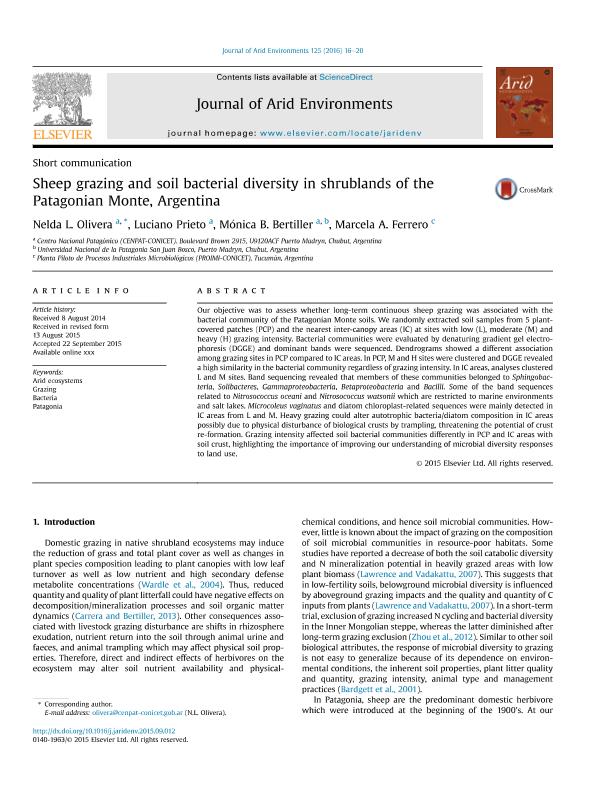Mostrar el registro sencillo del ítem
dc.contributor.author
Olivera, Nelda Lila

dc.contributor.author
Prieto, Luciano Hernan

dc.contributor.author
Bertiller, Monica Beatriz

dc.contributor.author
Ferrero, Marcela Alejandra

dc.date.available
2018-03-19T16:57:23Z
dc.date.issued
2016-02
dc.identifier.citation
Olivera, Nelda Lila; Prieto, Luciano Hernan; Bertiller, Monica Beatriz; Ferrero, Marcela Alejandra; Sheep grazing and soil bacterial diversity in shrublands of the Patagonian Monte, Argentina; Academic Press Ltd - Elsevier Science Ltd; Journal of Arid Environments; 125; 2-2016; 16-20
dc.identifier.issn
0140-1963
dc.identifier.uri
http://hdl.handle.net/11336/39212
dc.description.abstract
Our objective was to assess whether long-term continuous sheep grazing was associated with the bacterial community of the Patagonian Monte soils. We randomly extracted soil samples from 5 plant-covered patches (PCP) and the nearest inter-canopy areas (IC) at sites with low (L), moderate (M) and heavy (H) grazing intensity. Bacterial communities were evaluated by denaturing gradient gel electrophoresis (DGGE) and dominant bands were sequenced. Dendrograms showed a different association among grazing sites in PCP compared to IC areas. In PCP, M and H sites were clustered and DGGE revealed a high similarity in the bacterial community regardless of grazing intensity. In IC areas, analyses clustered L and M sites. Band sequencing revealed that members of these communities belonged to Sphingobacteria, Solibacteres, Gammaproteobacteria, Betaproteobacteria and Bacilli. Some of the band sequences related to Nitrosococcus oceani and Nitrosococcus watsonii which are restricted to marine environments and salt lakes. Microcoleus vaginatus and diatom chloroplast-related sequences were mainly detected in IC areas from L and M. Heavy grazing could alter autotrophic bacteria/diatom composition in IC areas possibly due to physical disturbance of biological crusts by trampling, threatening the potential of crust re-formation. Grazing intensity affected soil bacterial communities differently in PCP and IC areas with soil crust, highlighting the importance of improving our understanding of microbial diversity responses to land use.
dc.format
application/pdf
dc.language.iso
eng
dc.publisher
Academic Press Ltd - Elsevier Science Ltd

dc.rights
info:eu-repo/semantics/openAccess
dc.rights.uri
https://creativecommons.org/licenses/by-nc-sa/2.5/ar/
dc.subject
Arid Ecosystems
dc.subject
Bacteria
dc.subject
Grazing
dc.subject
Patagonia
dc.subject.classification
Otras Ciencias Biológicas

dc.subject.classification
Ciencias Biológicas

dc.subject.classification
CIENCIAS NATURALES Y EXACTAS

dc.title
Sheep grazing and soil bacterial diversity in shrublands of the Patagonian Monte, Argentina
dc.type
info:eu-repo/semantics/article
dc.type
info:ar-repo/semantics/artículo
dc.type
info:eu-repo/semantics/publishedVersion
dc.date.updated
2018-03-12T14:25:35Z
dc.journal.volume
125
dc.journal.pagination
16-20
dc.journal.pais
Estados Unidos

dc.journal.ciudad
New York
dc.description.fil
Fil: Olivera, Nelda Lila. Consejo Nacional de Investigaciones Científicas y Técnicas. Centro Nacional Patagónico; Argentina
dc.description.fil
Fil: Prieto, Luciano Hernan. Consejo Nacional de Investigaciones Científicas y Técnicas. Centro Nacional Patagónico; Argentina
dc.description.fil
Fil: Bertiller, Monica Beatriz. Consejo Nacional de Investigaciones Científicas y Técnicas. Centro Nacional Patagónico; Argentina. Universidad Nacional de la Patagonia; Argentina
dc.description.fil
Fil: Ferrero, Marcela Alejandra. Consejo Nacional de Investigaciones Científicas y Técnicas. Centro Científico Tecnológico Conicet - Tucumán. Planta Piloto de Procesos Industriales Microbiológicos; Argentina
dc.journal.title
Journal of Arid Environments

dc.relation.alternativeid
info:eu-repo/semantics/altIdentifier/doi/http://dx.doi.org/10.1016/j.jaridenv.2015.09.012
dc.relation.alternativeid
info:eu-repo/semantics/altIdentifier/url/https://www.sciencedirect.com/science/article/pii/S0140196315300586
Archivos asociados
